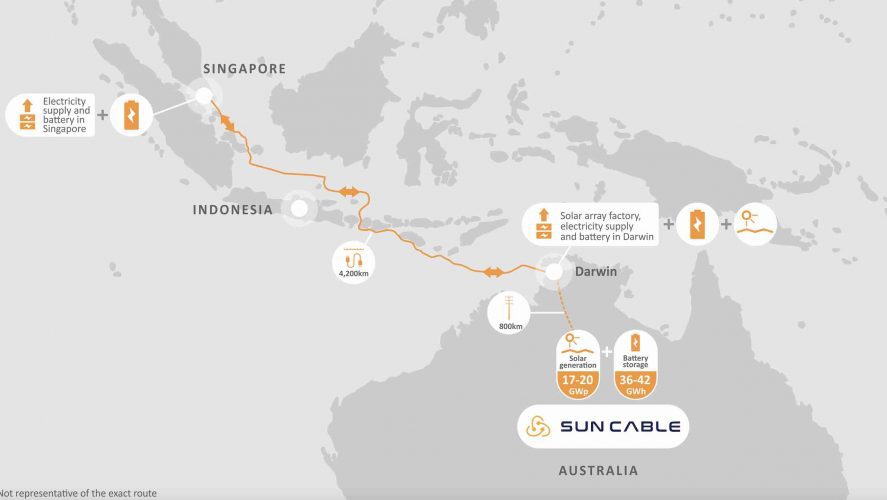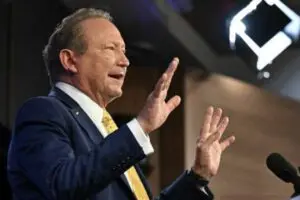Billionaires Mike Cannon-Brookes and Andrew Forrest have led another major capital raising for Sun Cable, which is planning to build the world’s biggest solar and battery storage facility, and is now eyeing other projects of a similar scale.
Sun Cable – which is proposing a solar farm of up to 20GW, backed by a battery of between 36GWh and 42GWh – announced late on Sunday that it had raised $A210 million in a Series B capital raising from existing shareholders.
The fund raising was led by Grok Ventures, the investment firm of tech billionaire Cannon-Brookes and his wife, and Squadron Energy, privately owned by iron ore billionaire Forrest.
Their share of the fund raising was not revealed, although RenewEconomy understands that their combined stake remains short of a half share, while nearly one half remains in the hands of founds David Griffin, the CEO, and brothers Mac and Fraser Thompson, who are the chief operating and chief strategy officers respectively.
Sun Cable is not just the world’s biggest proposed solar and battery project, it will also likely change the way the industry thinks about electricity supplies.
The prime purpose of what is officially known as the Australia-Asia PowerLink is to export power to Singapore, via a massive 4,200km sub-sea cable that will have capacity of around 2GW.
But around 800MW of capacity will also be delivered to Darwin, around four times the local grid’s current needs, which Griffin says reflects the huge demand from potential industrial users who demand – because their customers do as well – a zero emissions power supply.
The fund raising is the company’s first since late 2019, when Forrest and Canon-Brookes led a sub-$50 million raising. This new raising will help the now 80-strong team take AAPL through to financial close, possibly next year, and advance other similar large scale projects.
“Sun Cable has developed unique intellectual property to facilitate the optimal design of complex dispatchable renewable electricity generation and transmission projects,” Griffin said in a statement.
“We have developed a world leading capability in four short years. We are thrilled to have materially strengthened our resources with the support of all of our shareholders, who are such strong advocates for our mission.
“This capital raise will enable the delivery of renewable solar power from Australia to Singapore, advance our other multi gigawatt scale projects, and support the progress of key facilitating assets.”
Griffin would not reveal where the other projects might be located, but has made it clear that there are numerous other opportunities on the horizon, particularly for countries such as Australia with such massive renewable resources and know-how.
Cannon-Brookes, who has been making headlines recently with his audacious joint bid for Australia’s biggest coal generator and polluter AGL, with a plan to fast-track the closure of its coal generators, said the fund raising brings Australia one step closer to realising its renewables exporting potential.
“We can power the world with clean energy and Sun Cable is harnessing that at scale,” he said in a statement. It’s a blueprint for how we export energy across the world. We fully back this vision.”
Forrest, who has also been making a splash with the steady rollout of announcement to support his ambitious green hydrogen and green ammonia ambitions, said Sun Cable’s vision will transform Australia’s capability to be a world-leading generator and exporter of renewable electricity and to enable decarbonisation.
“I’m proud to be a cornerstone investor in Sun Cable, its team and its vision,” Forrest said. “This capital raise is a critical step in developing the Australia-Asia PowerLink and I applaud Sun Cable realising this mission.”

The latest update of the Sun Cable project paints a picture of a 12,000 hectare solar precinct with 17-20 GW of solar generation and 36-42 GWh energy storage based on a massive property near Elliott, in the Northern Territory.
Just for context, the total installed capacity of large scale solar in Australia right now is around 6.3GW, and the total utility scale battery storage is around 500MW/900MWh. So we are talking about more than three times the country’s solar capacity and around 40 times the battery storage capacity – in one project.
A high voltage direct current (HVDC) overhead transmission line will transmit 3GW of electricity from the Solar Precinct to the Darwin region, with 800MW of this renewable electricity capacity delivered to Darwin itself.
That is much higher than the local grid’s current capacity – more than four times. But Griffin told RenewEconomy there was huge demand from potential industrial users for zero emissions power.
“There is a huge amount of prospective industrial load in Darwin,” Griffin said. “Nearly all of those prospective loads need it to be 100% zero emissions. Their customers need to have that zero emission supply chain.”
Sun Cable has previously indicated that one major big battery would be built at Darwin, to support the export of power along the proposed cable, and it has also submitted plans for a massive manufacturing precinct.
Sun Cable has doubled in size since its ambitions first became public, but while it is the biggest solar and battery project proposal in the world, it is not the biggest renewable energy project proposal, even in Australia.
CWP Global and Hong Kong-based Intercontinental have proposed massive projects – one of 52GW and another of 26GW – that would combine wind and solar for use in the making of green hydrogen and green ammonia for domestic and international customers.
A number of other similar sized projects have been proposed for elsewhere in the world, including in the Middle East, Europe and the Americas.










